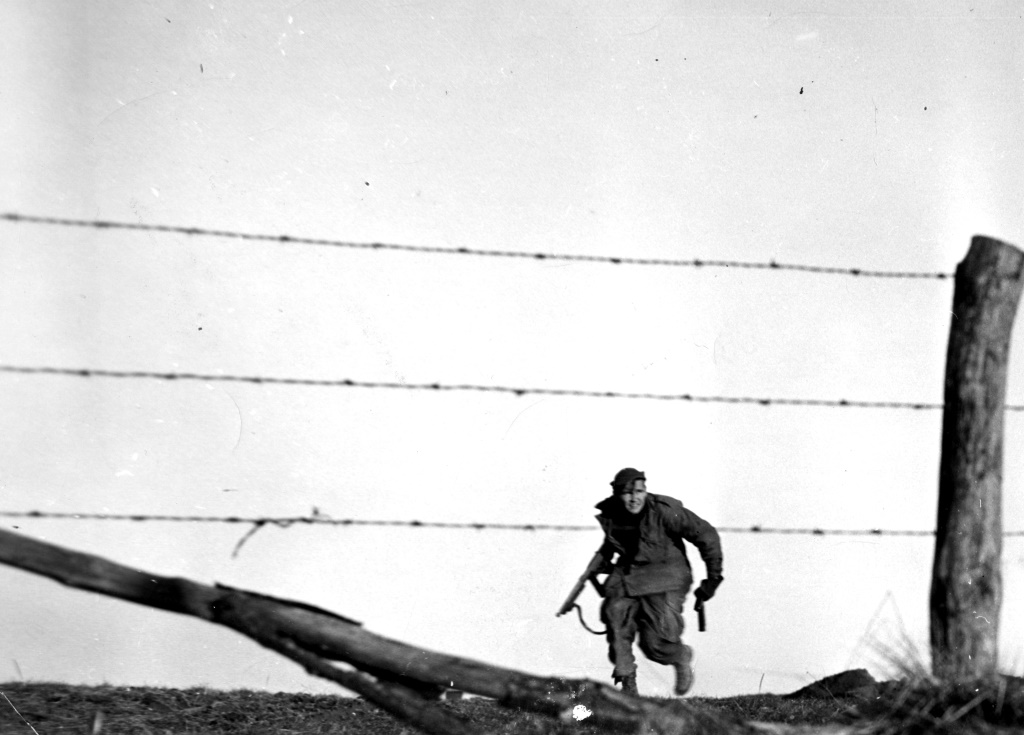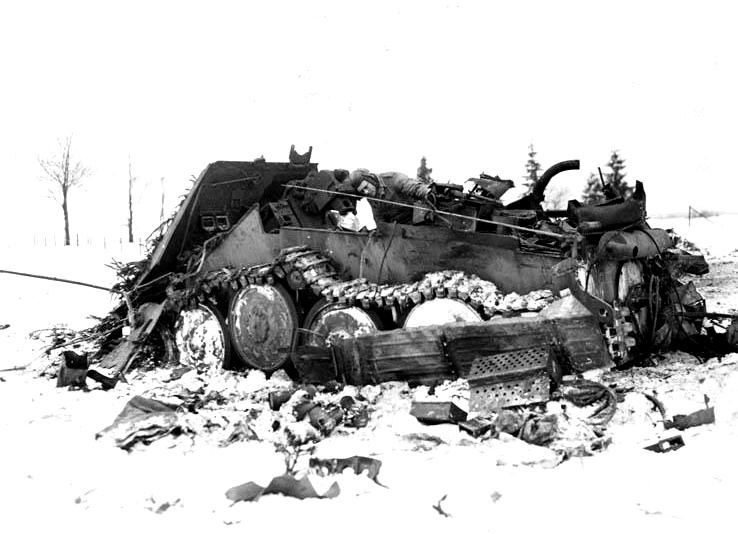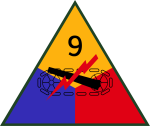
 By December 19, CCR 9-AD had been forced back to Longvilly seven miles east of Bastogne. CCB 10-AD dispatched to Bastogne on December 17 had established roadblocks around the town. These two armored units blocked the German attacks giving the 101-A/B time to consolidate its positions. It had closed in to xb>Bastogne during December 18-19. Originally sent there to attack it was soon to be engulfed in the defense of the city. Farther south, a small detachment of engineers and
By December 19, CCR 9-AD had been forced back to Longvilly seven miles east of Bastogne. CCB 10-AD dispatched to Bastogne on December 17 had established roadblocks around the town. These two armored units blocked the German attacks giving the 101-A/B time to consolidate its positions. It had closed in to xb>Bastogne during December 18-19. Originally sent there to attack it was soon to be engulfed in the defense of the city. Farther south, a small detachment of engineers and 
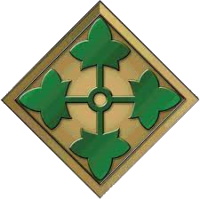 other troops were still holding out in Wiltz. Elements of the 110-IR (28-ID) was still holding out in isolated areas, positions unknown. The south shoulder continued to hold. CCA 10-AD was counterattacking in conjunction with elements of the 4-ID.
other troops were still holding out in Wiltz. Elements of the 110-IR (28-ID) was still holding out in isolated areas, positions unknown. The south shoulder continued to hold. CCA 10-AD was counterattacking in conjunction with elements of the 4-ID.

 The 82-A/B had closed into an assembly area in the vicinity of Werbomont during the night of 18-18 December. Going into positions in line due south of Werbomont it had moved forward to the Amblève – Salm Rivers, extending south to Vielsalm. In so doing their left flank along the Amblève, together with two battalions of 119-IR (30-ID) on the east and south, completed a ring around the leading elements of the 1.SS-PD. In the battle that followed the German tankers abandoned their vehicles and filtered back to the east and rejoined the assault units.
The 82-A/B had closed into an assembly area in the vicinity of Werbomont during the night of 18-18 December. Going into positions in line due south of Werbomont it had moved forward to the Amblève – Salm Rivers, extending south to Vielsalm. In so doing their left flank along the Amblève, together with two battalions of 119-IR (30-ID) on the east and south, completed a ring around the leading elements of the 1.SS-PD. In the battle that followed the German tankers abandoned their vehicles and filtered back to the east and rejoined the assault units.
The attack to gain St Vith, the key to the routes leading west still continued. Manteuffel had hoped to occupy it on December 17. He had kept his panzer divisions moving west through the existing gap and kept his infantry assaulting the town. Other than forcing slight withdrawals in the U-shaped defense the attack had failed. He now reinforced his assault units. Previously, the Fuehrer Escort Brigade had been sent around to the north flank and arrived in position on December 20, facing the 7-AD on the north flank. On December 21, a coordinated attack was made on the town and the defenders were driven back a short distance west of St Vith. Losses were heavy and in the forced withdrawal many of the units had lost cohesion. A defense line was hastily established, however, and the Germans, while gaining lateral roads were still denied access to the routes to the west.

 Meanwhile, around 1330 on December 19, the VIII Corps passed to the control of the US 3-A, the boundary re-established on a line St Vith – Givet. Further changes were forthcoming. At 13S0, December 20, the entire US 1-A and US 9-A passed to the control of British 21-AG. The group boundary as laid down by SHAEF ran eastward from Givet to Prüm then bent northward
Meanwhile, around 1330 on December 19, the VIII Corps passed to the control of the US 3-A, the boundary re-established on a line St Vith – Givet. Further changes were forthcoming. At 13S0, December 20, the entire US 1-A and US 9-A passed to the control of British 21-AG. The group boundary as laid down by SHAEF ran eastward from Givet to Prüm then bent northward 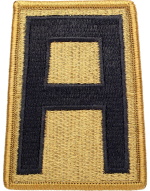
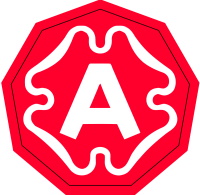 to Cologne. The action was prompted by several influencing factors, the chief being that the US 1-A and the US 3-A were cut in two, a sixty-mile gap existing between them at the base of the penetration. Radio communications were uncertain due to the weather and battle conditions. The Germans were certain to cut the telephone cables. Further, the impetus of the attack was to the north. The US 9-A and the US 1-A as well as the British 2-A were all needed to provide adequate security for the vital objectives north of the Meuse River.
to Cologne. The action was prompted by several influencing factors, the chief being that the US 1-A and the US 3-A were cut in two, a sixty-mile gap existing between them at the base of the penetration. Radio communications were uncertain due to the weather and battle conditions. The Germans were certain to cut the telephone cables. Further, the impetus of the attack was to the north. The US 9-A and the US 1-A as well as the British 2-A were all needed to provide adequate security for the vital objectives north of the Meuse River.

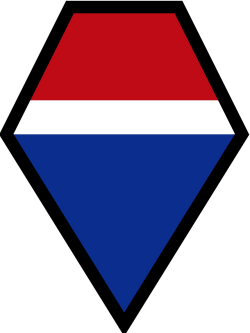 A commander was needed to coordinate the three armies, and under the circumstances, Montgomery was the logical choice. This action, which caused a storm of protest is still being criticized today. However, the criticism seems in most instances rather be a defense of Gen Omar N. Bradley (US 12-AG). Bradley was in need of attacking forces and no defense. Bastogne was now surrounded and the Germans were assaulting the defenses of the 101-A/B. The city, an important rail, and highway center, was becoming more vital to the success of the attack. Though the city could be bypassed, and German Armor was moving around it to the west it was a considerable handicap.
A commander was needed to coordinate the three armies, and under the circumstances, Montgomery was the logical choice. This action, which caused a storm of protest is still being criticized today. However, the criticism seems in most instances rather be a defense of Gen Omar N. Bradley (US 12-AG). Bradley was in need of attacking forces and no defense. Bastogne was now surrounded and the Germans were assaulting the defenses of the 101-A/B. The city, an important rail, and highway center, was becoming more vital to the success of the attack. Though the city could be bypassed, and German Armor was moving around it to the west it was a considerable handicap.
The US 3-A was now preparing to attack to the north from the vicinity of Luxembourg. The US III Corps, with the 80-ID, the 26-ID and the 4-AD were to attack northward astride the Arlon – Liège highway and relieve the 101-A/B and attached troops in Bastogne. The US XII Corps, with the 4-ID, the 5-ID plus CCA 10-AD and the Reserve Command 9-AD reinforced with the 2-CAV Group were to continue to hold the west bank of the Moselle River in its zone and be prepared to attaok to the north on army order.

 Originally scheduled for December 21, it opened on December 22. The VIII Corps, now badly disorganized, with 101-A/B, remnants of the 28-ID, plus CCR-9-AD and CCB-10-AD was to oontinue the defense of the sector east of the Meuse River. 0n the northern shoulder of the Ardennes, the XVIII Airborne Corps had become operative on December 19, assuming control of the 30-ID, the 84-ID, the 106-ID, the 82-A/B, the 3-AD (less CCA), the 7-AD and the 112/28-ID. The Corps Zone now extended west from Malmedy through Stavelot, Stoumont thence south to the vicinity of Vielsalm, then west to the vicinity of Marche.
Originally scheduled for December 21, it opened on December 22. The VIII Corps, now badly disorganized, with 101-A/B, remnants of the 28-ID, plus CCR-9-AD and CCB-10-AD was to oontinue the defense of the sector east of the Meuse River. 0n the northern shoulder of the Ardennes, the XVIII Airborne Corps had become operative on December 19, assuming control of the 30-ID, the 84-ID, the 106-ID, the 82-A/B, the 3-AD (less CCA), the 7-AD and the 112/28-ID. The Corps Zone now extended west from Malmedy through Stavelot, Stoumont thence south to the vicinity of Vielsalm, then west to the vicinity of Marche.  The VII Corps was relieved of its zone north of the V Corps and on December 22, was assembling north of Marche, with the 2-AD and the 75-ID. Its mission was to counterattack and screen right to the Meuse River.
The VII Corps was relieved of its zone north of the V Corps and on December 22, was assembling north of Marche, with the 2-AD and the 75-ID. Its mission was to counterattack and screen right to the Meuse River.
The 422/106-ID and 423/106-ID, without resupply in food and ammunition, unable to evacuate their casualties, their part of the ‘quiet front’ being located exactly between two of the main axes of the Germans penetration (Manderfeld – St Vith 6.Panzer-Army) and (Bliealf – Schoenberg – St Vith 5.Panzer-Army), consequently surrounded somewhere in the Schnee Eifel between Bliealf in Germany and Schoenberg in Belgium delivered a bloody but exceptional resistance causing tremendous casualties on the opposite side of their front. Finally, abandoned to their fate since the early stage of the counteroffensive on December 17, the men destroyed every combat means remaining and had no other choice than to surrender on December 20 after a half-hearted attempt to fight their way west to St Vith.
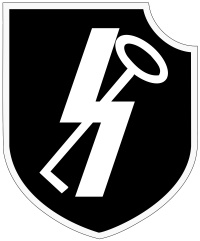
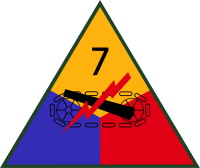 On December 22, the 12.SS-PD joined in an attack against the 7-AD and attached units making a stand west of St Vith. Already badly shaken from the attack the preceding day, the 7-AD succeeded in holding. Their position was precarious, however. No resupply had been effected since they entered the salient on December 17, and ammunition was low. By order of FM Montgomery, they were to withdraw. On the morning of December 23, a daylight withdrawal was begun, west across the Salm River north of
On December 22, the 12.SS-PD joined in an attack against the 7-AD and attached units making a stand west of St Vith. Already badly shaken from the attack the preceding day, the 7-AD succeeded in holding. Their position was precarious, however. No resupply had been effected since they entered the salient on December 17, and ammunition was low. By order of FM Montgomery, they were to withdraw. On the morning of December 23, a daylight withdrawal was begun, west across the Salm River north of  Vielsalm, passing through the lines of the 82-A/B. Accomplished during heavy German attacks, losses again were heavy. The American defense lines still denied the Germans the use of vital road nets to the north and west in the northern sector. The 6.Panzer-Army making the main thrust had stalled. Failure to attain first the Ridge in Elsenborn and then St Vith, its attack had stalled. Heavy reinforcements to its assaulting divisions had resulted in jammed roads, and many tanks bogged down in the mud.
Vielsalm, passing through the lines of the 82-A/B. Accomplished during heavy German attacks, losses again were heavy. The American defense lines still denied the Germans the use of vital road nets to the north and west in the northern sector. The 6.Panzer-Army making the main thrust had stalled. Failure to attain first the Ridge in Elsenborn and then St Vith, its attack had stalled. Heavy reinforcements to its assaulting divisions had resulted in jammed roads, and many tanks bogged down in the mud.
On December 18, the crowded roads provided targets for the American Air Force during the few hours of flying permitted by the weather. The weather from December 16 to December 23, for the most part, rendered air support impossible. The Germans had chosen this time to attack because weather forecasts had indicated fog for a period of several days. The stacking of assault units, one behind the other in the limited road space between the north flank and the salient in St Vith had been a tactical error on the part of Dietrich when his forces came on the same road as Manteuffel’s 5.PA. After the collapse of the St Vith salient, valuable time was lost clearing the area. Had Hitler and Mödel reinforced the 5.PA rather than the 6.PA the results might have been far different. Manteufel met his schedule westward until his supply lines gave way. He had kept his Panzer divisions moving west, bypassing the city of Bastogne, leaving its reduction to his infantry divisions with tank support. Dietrich, however, decided to make another try for routes to the north and west by an attack through the 82-A/B in the vicinity of Vielsalm. Here, the 82-A/B lines ran from Trois Ponts to Vielsalm then west to a crossroads north of Manhay where it joined with units of the 3-AD.
(Photo above) On December 24, 1944, men and vehicles of the US 7-AD were withdrawing behind the line hold by the 82-A/B. While moving to the rear, a Seargent in the turret of a tank destroyer spotted a GI digging a foxhole in the frozen ground. The GI, Pfc Martin (325-GIR) looked up and asked are you looking for a safe place? Yeah! answered the tanker. Well buddy drawled Martin just pull your vehicle behind me … I am the 82nd Airborne Division and this is as far as the bastards are going!

 The collapse of the St Vith defense left the 82-A/B with a salient at Vielsalm. On December 24, elements of the Fuehrer Begleit Brigade and 2.SS-PD (Das Reich) attacked, the 2.SS-PD striking at the junction of the 82-A/B and 3-AD, the 9.SS-PD (Hohenstaufen) directly west north of Vielsalm. The 2.SS-PD penetrated the town of Manhay, overrunning elements of the US 3-AD and
The collapse of the St Vith defense left the 82-A/B with a salient at Vielsalm. On December 24, elements of the Fuehrer Begleit Brigade and 2.SS-PD (Das Reich) attacked, the 2.SS-PD striking at the junction of the 82-A/B and 3-AD, the 9.SS-PD (Hohenstaufen) directly west north of Vielsalm. The 2.SS-PD penetrated the town of Manhay, overrunning elements of the US 3-AD and 
 US 7-AD. Fearing that the 82-A/B’s right flank would be turned and provide a gap for the Germans to pour through, and also probably influenced by his desire to Put on a tidy show FM Montgomery ordered the 82-AB to the higher ground several miles to the west.
US 7-AD. Fearing that the 82-A/B’s right flank would be turned and provide a gap for the Germans to pour through, and also probably influenced by his desire to Put on a tidy show FM Montgomery ordered the 82-AB to the higher ground several miles to the west.
 The line now ran due southeast from Trois Ponts to Manhay. Mistaking the withdrawal for a retreat the Germans regrouped and attacked again the following day. Though heavy, it was broken up after a slight penetration. This was to be the last heavy attack on the north flank. Unable to gain routes through the US 1-A’s lines on the Meuse they now concentrated on the south.
The line now ran due southeast from Trois Ponts to Manhay. Mistaking the withdrawal for a retreat the Germans regrouped and attacked again the following day. Though heavy, it was broken up after a slight penetration. This was to be the last heavy attack on the north flank. Unable to gain routes through the US 1-A’s lines on the Meuse they now concentrated on the south.
On December 23, the weather improved and Allied tactical planes were again in the air. 
 Numerous air strikes were made against tank columns and concentrations as well as supply trains. Their effect began to tell in the reduction of the pressure against the Allied lines. Lack of air support, both reconnaissance and combat aircraft had been a handicap in the early days of the attack. It was to prove invaluable in the reduction of the German salient.
Numerous air strikes were made against tank columns and concentrations as well as supply trains. Their effect began to tell in the reduction of the pressure against the Allied lines. Lack of air support, both reconnaissance and combat aircraft had been a handicap in the early days of the attack. It was to prove invaluable in the reduction of the German salient.

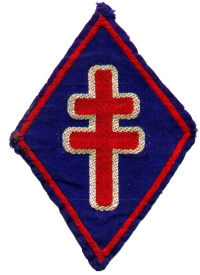 The VII Corps had been placed in the line and the north flank defense now extended from Butgenbach through Malmedy, Trois Ponts, Manhay, Laroche, Marche to the Meuse River at Givet where it joined the British 29th Household Cavalry Regiment. British units now defended the Meuse River line from Givet to Liège. South of Givet were the 17-A/B, the 11-AD, and several battalions of the French Army.
The VII Corps had been placed in the line and the north flank defense now extended from Butgenbach through Malmedy, Trois Ponts, Manhay, Laroche, Marche to the Meuse River at Givet where it joined the British 29th Household Cavalry Regiment. British units now defended the Meuse River line from Givet to Liège. South of Givet were the 17-A/B, the 11-AD, and several battalions of the French Army.

 Elements of the 2.SS-PD had penetrated into Celles, four miles from Dinant on the Meuse River, and into Ciney, four miles down the river. The US 2-AD, with British units, had destroyed them on December 25-26. The Germans’ situation was now precarious. They were stopped on the north and faced with the probability of a counterattack at any point on their right flank. They lacked sufficient road nets in the center of the area of penetration, and on the south, the US 3-A was already advancing northward. The possession of Bastogne, still held by the 101-A/B and its attached troops was of increasing importance.
Elements of the 2.SS-PD had penetrated into Celles, four miles from Dinant on the Meuse River, and into Ciney, four miles down the river. The US 2-AD, with British units, had destroyed them on December 25-26. The Germans’ situation was now precarious. They were stopped on the north and faced with the probability of a counterattack at any point on their right flank. They lacked sufficient road nets in the center of the area of penetration, and on the south, the US 3-A was already advancing northward. The possession of Bastogne, still held by the 101-A/B and its attached troops was of increasing importance.












